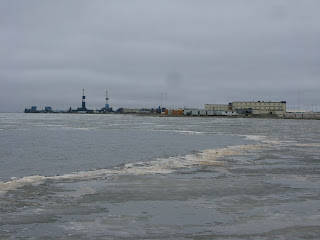Maybe I'm using a poor analogy, but like Bob Marshall, I've always been interested in places away from people - as he describes, "blank spaces on the map." At the same time, I'm no adventurer in any category like Bob Marshall or the many adventurers that run rivers that haven't been run before or walk places that haven't been walked before . . . and many other examples. But I do love the natural world and being away from other people. But what is "remote' in our day and age?
Yes, I've decided it is how many jet trails you see. A couple of years ago, we rafted the Tatshenshini-Alsek Rivers. What a great trip. We saw maybe 30 people in 10 days. But we saw regular jet trails as travelers flew over us from Juneau to Yakutat or Anchorage eating their free soy mix and quaffing one plastic glass of soda/pop.
In the Brooks Range? After our drop off at Circle Lake, we saw no other people for 7 days. It was 3 days before we saw a jet trail. And we did see one a couple of days later. Disappointingly, the fourth day of our trip we encountered 2 sightseeing single engine planes way up a canyon in the Arrigetch Mountains. And, finally, we heard another couple of small planes during the week, but never saw them.
And, in full disclosure, we arrived back in our Arrigetch Base Camp after a glorious day hike, greeted by a poorly written note noting that I (yes, it was me!) did not put my emergency Mountain House Rice and Chicken away in the bear proof can. I felt fortunate that someone in the National Park Service flew into the area at great expense in order to guard my safety.
Next time you go out remote, look for jet trails. The fewer that you see, the farther out you'll be. I know that I'll never see as few in one week as our Brooks Range trip.





















































